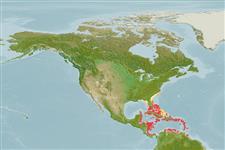Common names from other countries
>
Eupercaria/misc (Various families in series Eupercaria) >
Scaridae (Parrotfishes) > Sparisomatinae
Etymology: Sparisoma: Latin, sparus = a fish with a golden head + Greek, soma = body (Ref. 45335).
More on author: Valenciennes.
Environment: milieu / climate zone / depth range / distribution range
Ecología
marino asociado a arrecife; rango de profundidad 1 - 15 m (Ref. 9710). Tropical; 42°N - 7°N, 88°W - 59°W (Ref. 88982)
Western Atlantic and the Caribbean. Confused with Southwest Atlantic specimens referring to Sparisoma axillare and Eastern Atlantic species referring to S. chaoti (Ref. 88982).
Length at first maturity / Tamaño / Peso / Age
Maturity: Lm ?, range 16 - ? cm
Max length : 47.8 cm TL macho / no sexado; (Ref. 13628)
Espinas dorsales (total) : 9; Radios blandos dorsales (total) : 10; Espinas anales: 3; Radios blandos anales: 9. Juveniles and adults in drab phase (which are either mature males or females) are light grayish brown, nearly white ventrally; alternate dark and pale bars cross the chin; caudal peduncle and fin yellow; anal and pelvic fins red. Terminal phase males are dull green or blue-green with a large black spot on upper half of pectoral fin base; pectoral fins dark olive, the outer fifth abruptly pale (Ref. 13442).
Inhabits coral reefs and seagrass beds. Juveniles or primary-phase fish can rapidly assume a mottled pattern as it comes to rest on the bottom. Spawning is usually a group activity in similarly colored males and females (Ref. 5521). A protogynous hermaphrodite (Ref. 55367).
Life cycle and mating behavior
Maturities | Reproducción | Spawnings | Egg(s) | Fecundities | Larva
Although protogyny was propossed for this species (Ref. 27876), probably because testicular characteristics showed a secondary characteristic of sex-changed males, observations of overlapping size ranges of males and females, and males maturing at the same ages and sizes as did females, strongly suggest gonochorism (Ref. 103751). A monandric species (Ref. 55367). Length at sex change = 25.0 cm TL (Ref. 55367). Forms leks during breeding (Ref. 55367).
Lieske, E. and R. Myers, 1994. Collins Pocket Guide. Coral reef fishes. Indo-Pacific & Caribbean including the Red Sea. Haper Collins Publishers, 400 p. (Ref. 9710)
IUCN Red List Status (Ref. 130435)
CITES (Ref. 128078)
Not Evaluated
Threat to humans
Reports of ciguatera poisoning (Ref. 30303)
Human uses
Pesquerías: escaso valor comercial; Acuario: Comercial
Herramientas
Special reports
Download XML
Fuentes de Internet
Estimates based on models
Preferred temperature (Ref.
115969): 23.9 - 28.2, mean 27.5 (based on 467 cells).
Phylogenetic diversity index (Ref.
82804): PD
50 = 0.5000 [Uniqueness, from 0.5 = low to 2.0 = high].
Bayesian length-weight: a=0.00912 (0.00543 - 0.01532), b=3.05 (2.91 - 3.19), in cm Total Length, based on LWR estimates for this species & Genus-body shape (Ref.
93245).
Nivel trófico (Ref.
69278): 2.0 ±0.0 se; based on diet studies.
Resiliencia (Ref.
120179): Alto, población duplicada en un tiempo mínimo inferior a 15 meses (K=0.5).
Fishing Vulnerability (Ref.
59153): Low to moderate vulnerability (26 of 100).
